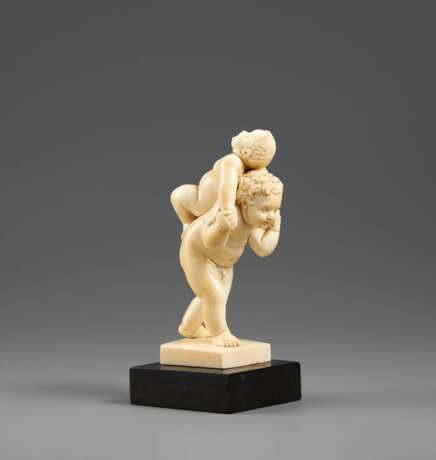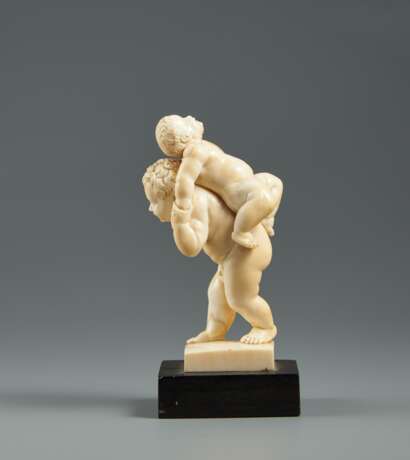ID 1072376
Lot 1205 | Leonhard Kern. Piggyback Group
Estimate value
€ 20 000 – 30 000
1588 Forchtenberg - 1662 Schwäbisch Hall
attributed
Title: Piggyback Group.
Technique: Ivory.
Height: 12cm.
Pedestal: Plinth.
Provenance:
Kunstkammer Georg Laue, Munich, purchased there by the present owner;
Private ownership, Germany.
Licence to sell (CITES) is available.
The small box appears concentratted while heartiky striding on his little short legs. On his back he is carrying an even younger, smaller crony. The way he is carrying him - back to back - and the overjoyed facial expression of the carried boy indicate that it is a spontaneous child's play in the depiction. Both naked boys will not be able to travel a long distance like this. It is a rather playful variation of the common piggyback rides, a "this works, too".
The small figurine bribes due to its many details with its realism and shows hereby a masterly observation and manual execution of the highest level.This way the position of the carrying boy is slightly unstable; with his left foot he is supporting himself by playing his left foot against the small of the carrier's back , his right foot, however, is searching support at the side of his friend's hip. Also, the variational execution of the both boys' hair is convincing; thicker and curlier is the elder one's head, the hair of the younger child is displayed thinner and more graphic. The round small children's bodies with their typical fat folds are executed in a highly convincing manner.
Due to the high quality and by means of the comparative examples in German and international museums (amongst others Hamburg, Museum für Kunst und Gewerbe; Schwäbisch Hall, Slg. Würth; Weimar, Stiftung Weimarer Klassik) this small figure ensemble is attributed to the presumably most significant German sculptor from 17th century, Leonhard Kern, the "German Giambologna".
Leonhard Kern was born in 1588 in Forchtenberg (Shire Hohenlohe) into a Lutheran scupltor family. His father and brothers finalised predominantly large-scale sculptures and tombs. After his education by his older brother, Leonhard Kern studied in Italy from 1609 to 1613. After his return the young talented artist stood out and was entrusted with several prstigeous commissions for large-scale sculptures (amongst others figural decoration of the Nürnberg townhall portals).
In 1620, Leonhard Kern founded an own workshop in Schwäbisch Hall and specialised in small-scale figurines of wood and ivory that he would create for princely and upper class art chambers and cabinets of curiosities but also the young art market and would sell them to significant collections via agents all over Europe.
Leonhard Kern devised depictions of children in constantyl new variances, probably influenced by impressions he gathered on his Italy travel but possibly by his own large crowd of children, as well (eleven boys, six girls). The present endearing sculpture can be dated to the 1630s on the basis of 1632 dated drawings of highly comparable sculptures. Amidst the Thirty Years' War a Protestant artist devised a sculpture of playing children that he executed in the then highly exquisite ivory (next to it alo a bronze sculpture).
Apart from the obvious depiction the children's zest for life may be preceived by the observers back then just as today as an invitation to indulge in "Carpe Diem" (Use the day) - and reply to perils "this works too".
| Artist: | Leonhard Kern (1588 - 1662) |
|---|---|
| Auction house category: | Sculptures |
| Artist: | Leonhard Kern (1588 - 1662) |
|---|---|
| Auction house category: | Sculptures |
| Address of auction |
VAN HAM Kunstauktionen GmbH Hitzelerstr. 2 50968 Köln Germany | ||||||||||||||
|---|---|---|---|---|---|---|---|---|---|---|---|---|---|---|---|
| Preview |
| ||||||||||||||
| Phone | +49 221 92586215 | ||||||||||||||
| Fax | +49 221 92 58 62 4 | ||||||||||||||
| Buyer Premium | 32% | ||||||||||||||
| Conditions of purchase | Conditions of purchase | ||||||||||||||
| Business hours | Business hours
|






